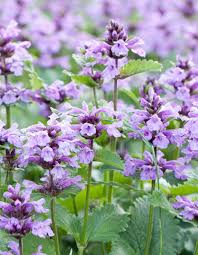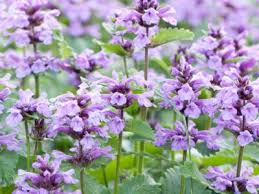Catmint is a plant that many people like to have in their gardens. It’s not just any plant, though it’s special because it makes cats really happy. You might wonder why, but there’s a good reason. Catmint has a scent that cats love, and when they smell it, they often roll around in it or chew on its leaves. It’s like cat candy.
Catmint, also known as Nepeta cataria, is a herbaceous perennial. That’s a fancy way of saying it’s a plant that comes back year after year. It’s part of the mint family, which means it’s related to plants like peppermint and spearmint, but it has its unique characteristics.
One great thing about catmint is that it’s easy to grow. You don’t need to be a gardening expert to have a healthy catmint plant in your yard. It likes to be in a sunny spot with well-drained soil. If you have a garden, you can plant it in the ground, or if you don’t, you can even grow it in a pot on your balcony.
When catmint blooms, it produces pretty flowers that are usually blue or purple. These flowers attract not only cats but also bees and butterflies. So, it’s not just a treat for your feline friends but also a lovely addition to your garden that supports pollinators.
Catmint has been used for centuries for its medicinal properties. People have made teas and herbal remedies from catmint to help with things like indigestion, anxiety, and even to relieve cold symptoms. But remember, just because it’s good for cats, it doesn’t mean you should use it as a medicine for yourself without consulting a healthcare professional.
However, catmint is a delightful and easy-to-grow plant that brings joy to both cats and gardeners. Its simple care requirements make it an excellent choice for anyone looking to add a touch of nature to their outdoor space. Whether you’re a cat lover or simply enjoy the sight of beautiful, fragrant flowers, catmint is a wonderful addition to any garden.
How to Grow the Catmint Plant

Growing catmint is a straightforward and enjoyable gardening experience. Here are simple steps to help you grow catmint in your garden:
1. Choose the Right Location: Catmint thrives in well-draining soil and prefers full sun to light shade. Ensure that the area you choose receives at least 6 hours of sunlight each day.
2. Prepare the Soil: Catmint isn’t too picky about soil type but prefers slightly alkaline soil. Before planting, amend the soil with compost to improve its fertility and drainage.
3. Planting: You can plant catmint from either seeds or nursery-bought plants. If using seeds, sow them in early spring or late summer, following the package instructions. If using nursery plants, space them about 18 to 24 inches apart.
4. Watering: Initially, water your catmint regularly to help establish the roots. Once established, catmint is drought-tolerant, so you won’t need to water it frequently. Water when the soil becomes dry, but be careful not to overwater, as catmint doesn’t like soggy soil.
5. Mulch: Applying a layer of mulch around the base of your catmint plants can help conserve moisture and suppress weeds.
6. Pruning: Catmint tends to get leggy and may benefit from occasional pruning. Trim back the spent flowers to encourage more blooms and cut the entire plant back by about one-third in early summer to promote bushier growth.
7. Fertilizing: Catmint doesn’t require much fertilizer. You can add a balanced, slow-release fertilizer in the spring to give it a boost, but avoid excessive fertilization, as this can lead to excessive foliage growth with fewer flowers.
8. Pest and Disease Control: Catmint is generally resistant to most pests and diseases. However, it can attract aphids, which are usually not a major problem. If aphids appear, you can rinse them off with a strong stream of water or use insecticidal soap as a last resort.
9. Dividing: Over time, catmint can become crowded. Every few years, consider dividing mature plants in the spring or early fall to rejuvenate them and create new plants.
10. Enjoy the Benefits: Catmint will reward you with beautiful spikes of blue or purple flowers and a delightful fragrance. Be prepared for visiting cats and pollinators like bees and butterflies to enjoy it as well.
Remember that catmint is a hardy and low-maintenance plant, making it an excellent choice for both beginner and experienced gardeners. It’s a versatile addition to any garden, adding beauty and attracting beneficial wildlife.
Read Also: 23 Medicinal Health Benefits of Citrus latipes (Khasi Papeda)
10 Health Benefits of the Catmint Plant

Catmint, also known as Nepeta cataria, offers several potential health benefits, although it’s essential to use it wisely and consult with a healthcare professional when needed. Here are ten health benefits associated with the use of catmint:
1. Digestive Aid: Catmint has traditionally been used to soothe digestive issues such as indigestion, gas, and bloating. Drinking catmint tea may help alleviate these discomforts.
2. Calming Properties: Catmint has mild sedative effects, which can help reduce anxiety and promote relaxation. It may be used to ease nervousness and mild stress.
3. Headache Relief: Some people find that catmint tea or catmint-infused oil applied topically on the temples can help relieve tension headaches and migraines.
4. Respiratory Health: Inhaling the aroma of catmint leaves may provide relief from congestion associated with colds and respiratory infections. It may help open up airways and ease breathing.
5. Pain Relief: Catmint contains compounds that have analgesic (pain-relieving) properties. It may be used topically as an herbal compress or poultice to ease muscle aches and pains.
6. Menstrual Symptom Relief: Some women have reported that catmint tea can help alleviate menstrual cramps and discomfort. Its muscle-relaxing properties may provide relief during menstruation.
7. Anti-Inflammatory Effects: Catmint contains compounds with anti-inflammatory properties. It may help reduce inflammation in conditions such as arthritis or joint pain.
8. Antibacterial and Antifungal Properties: Catmint’s essential oil has shown antibacterial and antifungal activity. It may be used topically to clean and disinfect minor wounds or skin irritations.
9. Improved Sleep: Due to its calming effects, catmint tea may help individuals with mild insomnia or difficulty falling asleep. It can promote a sense of relaxation conducive to restful sleep.
10. Appetite Stimulation: Catmint may stimulate appetite in individuals who have lost their appetite due to illness or other health issues. It can be helpful in encouraging food intake.
While catmint offers these potential health benefits, it’s important to use it in moderation and consult with a healthcare professional, especially if you are pregnant, nursing, or taking medications. Additionally, some individuals may be allergic to catmint, so it’s advisable to perform a patch test before using it topically. Always use catmint as a complementary therapy and not as a substitute for medical treatment when needed.
10 Benefits of Growing Catmint Plant
Catmint, also known as Nepeta cataria, offers several benefits beyond its appeal to cats. Here are ten benefits of catmint:
1. Cat Attraction: Catmint contains a compound called nepetalactone that cats are highly attracted to. It can provide entertainment and stimulation for your feline friends when grown in your garden.
2. Medicinal Uses: Catmint has been used for its medicinal properties for centuries. It can help with digestive issues, anxiety, and even relieve cold symptoms when brewed into a tea or used in herbal remedies.
3. Low Maintenance: Catmint is an easy-to-care-for plant, making it a great choice for beginner gardeners. It’s drought-tolerant and doesn’t require extensive maintenance.
4. Pollinator Magnet: The fragrant flowers of catmint attract bees, butterflies, and other pollinators to your garden, helping to support local ecosystems and promote biodiversity.
5. Aromatic Foliage: Catmint’s aromatic leaves emit a pleasant, minty fragrance when brushed against or crushed, adding a delightful scent to your garden.
6. Ornamental Value: Catmint produces beautiful spikes of blue or purple flowers that add color and visual appeal to your garden landscape. It can be a lovely addition to flower beds and borders.
7. Deer and Rabbit Resistant: Catmint is relatively resistant to browsing by deer and rabbits, making it a good choice for gardens in areas with these animals.
8. Natural Insect Repellent: Some gardeners use catmint as a natural insect repellent. While it attracts pollinators, it can deter certain insect pests like aphids and squash bugs.
9. Companion Planting: Catmint can be planted near vegetables like tomatoes and cabbage to help deter aphids and other pests that commonly affect these crops.
10. Culinary Uses: While not as commonly used as other mints, catmint leaves can be used sparingly in culinary dishes, teas, or as a garnish. It adds a unique, mild minty flavor.
Whether you’re a cat lover, a gardener, or simply someone who enjoys the beauty and benefits of plants in your outdoor space, catmint is a versatile and valuable addition to your garden. It provides enjoyment for cats, supports pollinators, and offers various practical uses, all while requiring minimal care.
Read Also: Principles of Plant Analysis Data Interpretation
Catmint Walkers Low

Catmint Walker’s Low is a lovely plant that can make your garden look fantastic without much fuss. It’s called Walker’s Low, but it doesn’t actually grow low – it can reach about 24 to 30 inches tall and spreads out nicely.
Catmint ‘Walker’s Low’ has pretty, gray-green leaves that are shaped like small hearts. These leaves have a pleasant scent when you touch them. In the summer, it produces a profusion of small, tubular lavender-blue flowers that stand out beautifully against the foliage.
Growing Catmint ‘Walker’s Low’ is easy-peasy. It likes sunshine but can tolerate a bit of shade. The soil should be well-draining, and you don’t need to pamper it with lots of water. It’s quite drought-tolerant once established.
Once you have planted the Walker’s Low, it doesn’t demand a lot of attention. You can trim it back after the first flush of flowers to encourage more blooms and maintain its shape. But if you forget or don’t have the time, it’ll still look pretty good.
One of the best things about this Catmint is that it blooms for a long time, often from late spring into early fall. That means you get those gorgeous blue flowers for months on end, which can be a treat for you and a delight for pollinators like bees and butterflies.
Walker’s Low Catmint is a magnet for beneficial insects. Bees love it, and it can help support your local bee population. Having more bees around can also improve the pollination of other plants in your garden.
If you have problems with deer or rabbits munching on your plants, you will be pleased to know that ‘Walker’s Low’ Catmint is usually unappetizing to them. It’s like having a natural deer and rabbit repellent in your garden.
You can plant Walker’s Low in flower beds, borders, or even in containers. It’s a versatile plant that can fit into various garden designs. It looks fantastic when planted in groups or as a backdrop to other colorful flowers.
The fragrance of Catmint ‘Walker’s Low’ is soothing and enjoyable. If you brush against it while walking in your garden, you’ll likely notice a pleasant minty aroma. It can add to the overall relaxation and enjoyment of your outdoor space.
In summary, Catmint ‘Walker’s Low’ is a simple yet beautiful plant that can enhance your garden effortlessly. It’s easy to grow, low-maintenance, and brings lovely blue flowers and a delightful scent to your outdoor space. Whether you are a seasoned gardener or just starting out, this Catmint is a great choice to consider.
Read Also: Man Utd plot January swoop for Juventus ace Federico Chiesa to replace Jadon Sancho!
